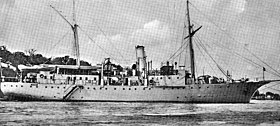SMS Seagull (1906)
 Survey ship SMS Möwe . Location and date of recording unknown. |
|
| Overview | |
|---|---|
| Type | Survey ship |
| Shipyard |
Kaiserliche Werft Wilhelmshaven |
| Keel laying | 1906 |
| Launch | July 2, 1906 |
| Namesake | Sea bird seagull |
| 1. Period of service |
|
| Commissioning | March 12, 1907 |
| Whereabouts | sunk in Dar es Salaam on August 8, 1914 |
| Technical specifications | |
| displacement |
Construction: 653 ts |
| length |
KWL : 49 m |
| width |
9.84 m |
| Draft |
2.80 - 3.26 m |
| crew |
104 men |
| drive |
|
| speed |
9.5 kn (max. 9.8 kn) |
| Range |
3820 nm at 7 kn |
| Armament |
3 × 3.7 cm revolver cannons |
| stock |
160 tons of coal |
SMS Möwe was a survey ship of the German Imperial Navy . The only sister ship was the Planet .
technology
The ship was on 2 July 1906, the Imperial Shipyard Wilhelmshaven of stack . It had a displacement of about 650 tons. In the winter of 1906 the ship was ready for service. The gull was between perpendiculars 49.0 m long, 9.84 m wide and had a depth m of 3.26. Two steam engines with a total output of 258 kW (350 PSi) enabled a maximum speed of 9.5 knots . The crew consisted of 104 men. The ship was armed with three 3.7 cm revolver cannons .
commitment
The seagull was mainly used in the German colonies and foreign waters in the surveying service. Nevertheless, she undertook her first survey trips in the North and Baltic Seas. In May 1911 she left Wilhelmshaven for astronomical, magnetic, meteorological and oceanographic investigations on the Atlantic coasts of Europe and Africa. After staying in West and South West Africa, the seagull moved to German East Africa at the end of 1912 and continued its measurements there. Among other things, the crew gathered information about the water conditions off West Africa and the subsea structure off the Congo estuary. A trip to the Indian Ocean for deep-sea research was planned for 1914, but this no longer took place due to the First World War.
On August 8, 1914, the ship in Dar es Salaam was blown up by its own crew. The artillery was dismantled, the team was transferred to the Schutztruppe for German East Africa under Lieutenant Colonel Paul von Lettow-Vorbeck and until 1916 was mainly used on Lake Tanganyika as the "Seagull Division", where it was used until the Allied offensive with a small fleet of subsequently armed sea steamers strongest force on the lake. The Seagull Division was withdrawn from Kigoma in July 1916 and dissolved in Tabora in September 1916 and distributed to other units of the Schutztruppe.
The end
The wreck of the seagull was lifted by Commander Ingles in 1922 and laid on the beach in Dar es Salaam harbor . In the following years it was gradually scrapped.
Philatelic meaning
The postage stamp inventory of the marine ship mail of the seagull was used up together with the inventory of the Königsberg in German East Africa. The stamps were distributed to eight medium-sized post offices, where they were used in the office on parcel cards. These stamps are known among philatelists under the term "Königsberg edition", although the greater part came from the stock of the seagull .
Individual evidence
- ↑ a b c d Hans Karr: Typenkompass - German research ships since 1905. Pietsch, Stuttgart 2015, ISBN 978-3-613-50811-8 , p. 71 f.
- ^ A b Albert Röhr: German Marine Chronicle. Verlag Gerhard Stalling, Oldenburg / Hamburg 1974, ISBN 3-7979-1845-3 , p. 195.
- ↑ Information in source (Dieter Jung: The ships of the Imperial Navy 1914–1918 and their whereabouts , pp. 54/55) in engl. long tons.
- ↑ Reinhard K. Lochner: Battle in the Rufiji Delta. - The end of the small cruiser »Königsberg«. The German Navy and Schutztruppe in East Africa during World War I. Munich, 1987, ISBN 3-453-02420-6 , p. 73.
- ↑ A picture in Shipwrecks and salvage on the East African coast shows the relatively well-preserved hull in 1930.
literature
- Dieter Jung: The ships of the Imperial Navy 1914–1918 and their whereabouts , Bernard & Graefe Verlag, Bonn 2004, ISBN 3-7637-6247-7
- Kevin Patience: Shipwrecks and salvage on the East African coast , Kingdom of Bahrain, Arabian Gulf 2006, p. 168.
Web links
- Brief description with picture
- Gustav Zimmer: Report by SMS Möwe on the period from December 8th, 1913 until the outbreak of war with the Möwe's crew list in 1914
- Markus Felten: World War I on the lakes of German East Africa (PDF file; 6.0 MB)
- Photo of the submerged seagull , picture collection of the German Colonial Society in the University Library in Frankfurt am Main